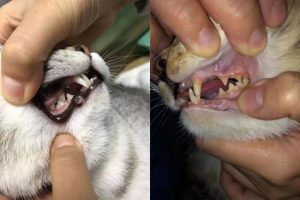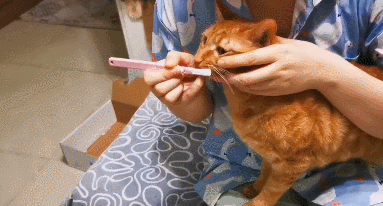As every cat owner knows, the best way to prevent feline dental disease is—brushing your cat’s teeth!Most pet parents have thought about brushing their cat’s teeth at some point, but for one reason or another… it never quite happens.You can’t pry open their mouth, they wriggle out of your arms, they just lick the toothpaste, or the toothbrush won’t even fit—there’s always some new challenge!In this guide, we’ll walk you through a step-by-step, beginner-friendly routine to help you finally succeed in brushing your cat’s teeth like a pro!
-
Help Your Cat Get Used to Being Touched
The key to successful toothbrushing starts long before you even pick up the toothbrush. Preparation includes three crucial steps:① Let your cat get used to having their face touched;② Help your cat tolerate you opening their mouth;③ Teach your cat to accept foreign objects (like your hand or a toothbrush) in their mouth.These steps take time and patience—but they’re the foundation of success! While you’re practicing Step 1, you can also start shopping for your brushing tools.(1) Getting your cat used to face touches.Try gently stroking your cat’s cheeks with your hand. Don’t be surprised—most cats will instinctively pull away or turn their heads.If your cat doesn’t struggle too hard, keep repeating this step every now and then. Each time you touch their face, reward them with a small treat afterward. Gradually increase how long you can touch before they pull away.If your cat only turns their head but doesn’t walk away → keep practicing, extend the time slowly, and move on to the next step when they’re calm.If your cat walks away → give them a tasty treat and try again later (a good time is right after they wake up or before mealtime; practice several times a day).If your cat swats or bites → stop immediately and reward them with food. Try again later that day or the next day. Over time, your cat will get used to facial touches.(2) Helping your cat get used to mouth touches.Now transition from the cheeks to the mouth area. Gently use your fingers to lift or slightly open your cat’s cheeks. Most cats will clamp their jaws shut—don’t worry, this is normal and doesn’t stop you from brushing later.Repeat the exercise just like before. Start with one second, reward with a treat, then try three seconds, and so on.If your cat lets you hold for one second without running → great! Continue building up gradually: one second, then two, then three…If your cat struggles or walks away → give a treat, let them relax, and try again before mealtime (a hungry cat is usually more cooperative).If your cat hits or bites → go back to the previous step.(3) Introducing foreign objects (the “toothbrush”).Now it’s time to help your cat accept having something in their mouth—this could be a pet toothbrush, a baby toothbrush, your finger, a finger brush, or even gauze.If you already have pet toothpaste, put a small amount on the brush or gauze and let your cat lick it. If not, you can use a cat treat paste instead.If your cat licks the toothpaste or treat from the toothbrush → try putting the brush into their mouth for one second. Next time, try two seconds, then three.If your cat turns away → switch to a different flavor or treat, smear it on the brush, and try again (ideally before mealtime).If your cat refuses that toothbrush entirely → change the toothpaste (or treat), the brush, or even the location (cats associate smells and environments strongly).When you can hold your cat steady, place the toothbrush with treat paste in their mouth for about three seconds, and your cat just wriggles a bit but doesn’t attack—and still eats the treat—congratulations, you’re 95% there!

-
Start Brushing
If brushing alone feels difficult, try having two people: one to hold the cat, and one to do the brushing.It’s normal for most cats to resist at first. Stay calm—some gentle firmness is okay—but if your cat becomes too upset, stop immediately and try again another day.Step-by-step brushing:① Prepare your tools — toothpaste, toothbrush, and reward treats. Use cat-safe toothpaste or any edible paste your cat enjoys. The toothbrush can be any of the options mentioned earlier. Choose treats your cat absolutely loves!② Hold your cat securely — use whichever position your cat is most comfortable with, as long as you can see their teeth.③ Lift the lips — just like you practiced during prep.④ Insert the toothbrush — don’t panic! Both you and your cat have practiced this many times. This is why the early steps matter so much.⑤ Brush the teeth — move the brush to the back molars and gently scrub up, down, and sideways.If you manage to brush for five seconds, congratulations—you’ve done it!Don’t underestimate those few seconds. Spending just five seconds every day or every other day can make a huge difference in your cat’s dental health.So even if it doesn’t look “perfect,” it still counts as brushing! Reaching every molar perfectly is tough, but even partial cleaning does wonders for oral hygiene.Don’t overthink it—just give it a try!
-
Advanced Brushing Challenge
Ready to take it to the next level? Here’s how to gradually level up your cat’s brushing routine:Stage 1: Brush 3–5 strokes on the top, bottom, left, and right sides.Stage 2: Adjust your tools—start with something easy like gauze + treat paste, then move toward a more effective combo like toothbrush + toothpaste.Stage 3: Focus on target areas, especially the upper molars on the cheek side, where the teeth meet the gums—this is where plaque and tartar build up the fastest.Stage 4: Try brushing the lower teeth. Your cat will likely keep their jaws clenched, but that’s okay. To reach the lower teeth, gently press near the canine teeth or open the mouth wider with your fingers.
Common Question: “If I give my cat a treat after brushing, doesn’t that defeat the purpose?”Absolutely not! Think about it—we brush our teeth in the morning and still eat breakfast afterward, right?The key to brushing your cat’s teeth is consistency, not perfection. What really matters is keeping up the habit.And for many cat parents, the biggest challenge is their cat’s resistance. If giving a little treat helps make the experience more positive, then it’s absolutely worth it!Just remember to offer small bites and keep an eye on calorie intake. The goal is to reward cooperation, not overfeed.From the first day your cat sees a toothbrush to the day they finally accept brushing, it might take weeks or even months. That’s completely normal!As a dedicated cat parent, you’ll need plenty of patience and persistence to protect your furry friend’s oral health.This guide may sound detailed—but remember, practice is what truly makes progress. So grab that toothbrush, stay calm, and keep going—your cat’s smile will thank you!





